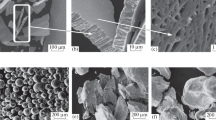Abstract—
We have demonstrated two processes for the synthesis of zinc antimonide powder using rapid melt cooling: melt spinning and cooling in a liquid. The elemental and phase compositions and surface morphology of hot-pressed undoped and 3 wt % In-doped β-Zn4Sb3 samples have been studied by scanning electron microscopy, X-ray diffraction, and optical microscopy, and their Seebeck coefficient, electrical conductivity, and thermal conductivity have been measured in the range 300–700 K. Indium doping has been shown to reduce the lattice thermal conductivity of the material by a factor of 1.5. The 600-K thermoelectric figure of merit of the undoped sample (ZT = 0.8) is half that of the doped sample (ZT = 1.5). We have assessed the effect of thermal cycling in the range 300–700 K on the Seebeck coefficient and electrical conductivity of the samples.









Similar content being viewed by others
REFERENCES
Ioffe, A.F., Poluprovodnikovye termoelementy (Semiconducting Thermoelectric Elements), Moscow: Akad. Nauk SSSR, 1960.
Vuillard, G. and Hiton, J.-P., Sur les transformations des phases intermetalliques du system antimone–zinc, C. R. Acad. Sci., 1966, vol. 263, no. 17, pp. 1018–1021.
Lo, C.-W.T., Svitlyk, V., Chernyshov, D., and Mozharivskyj, Y., The updated Zn–Sb phase diagram. how to make pure Zn13Sb10 (“Zn4Sb3”), Dalton Trans., 2018, vol. 47, pp. 11512–11520.https://doi.org/10.1039/C8DT02521E
Cargnoni, F., Nishibori, E., Rabiller, P., Bertini, L., Snyder, G.J., Christensen, M., Gatti, C., and Iversen, B.B., Interstitial Zn atoms do the trick in thermoelectric zinc antimonide, Zn4Sb3: a combined maximum entropy method X-ray electron density and ab initio electronic structure study, Chem. – Eur. J., 2004, vol. 10, pp. 3861–3870.https://doi.org/10.1002/chem.200400327
Mozharivskyj, Y., Janssen, Y., Harringa, J.L., Kracher, A., Tsokol, A.O., and Miller, G.J., Zn13Sb10: a structural and Landau theoretical analysis of its phase transitions, Chem. Mater., 2006, vol. 18, pp. 822–831.https://doi.org/10.1002/chin.200615016
Snyder, G.J., Christensen, M., Nishibori, E., Caillat, T., and Iversen, B.B., Disordered zinc in Zn4Sb3 with phonon-glass and electron-crystal thermoelectric properties, Nat. Mater., 2004, vol. 3, pp. 458–463.https://doi.org/10.1038/nmat.1154
Caillat, T., Fleurial, J.-P., and Borshchevsky, A., Preparation and thermoelectric properties of semiconducting Zn4Sb3, J. Phys. Chem. Solids, 1997, vol. 58, pp. 1119–1125.https://doi.org/10.1016/S0022-3697(96)00228-4
Panchenko, V.P., Tabachkova, N.Yu., Ivanov, A.A., Senatulin, B.R., and Andreev, E.A., Preparation and properties of Zn4Sb3-based thermoelectric material, Semiconductors, 2017, vol. 51, no. 6, pp. 714–717.https://doi.org/10.1134/S1063782617060252
Ivanova, L.D., Granatkina, Yu.V., Mal’chev, A.G., Nikhezina, I.Yu., Nikulin, D.S., Krivoruchko, S.P., Zaldastanishvili, M.I., and Sudak, N.M., Using advanced technologies for the preparation of nanoparticulate solid solutions between bismuth and antimony chalcogenides via rapid melt solidification, in Perspektivnye tekhnologii i materialy (Promising Technologies and Materials), Sevastopol’sk. Gos. Univ., 2020, pp. 70–74.
Ivanova, L.D., Granatkina, Yu.V., Mal’chev, A.G., Nikhezina, I.Yu., Krivoruchko, S.P., Zaldastanishvili, M.I., Vekua, T.S., and Sudak, N.M., Preparation and thermoelectric properties of microcrystalline lead telluride, Inorg. Mater., 2020, vol. 56, no. 8, pp. 791–798. https://doi.org/10.1134/S0020168520080063
Timothy, C.-W., Kolodiazhnyi, T., Song, Sh., Tseng, Yu-Ch., and Mozharivskyj, Y., Experimental survey of dopants in Zn13Sb10 thermoelectric material, Intermetallics, 2020, vol. 123, paper 106831.https://doi.org/10.1016/j.intermet.2020.106831
Tapiero, M., Tarabichi, S., Gies, J.G., Noguet, C., Zielinger, J.P., Joucla, M., Loison, J.L., Robino, M., and Herion, J., Preparation and characterization of Zn4Sb3, Sol. Energy Mater., 1985, vol. 12, pp. 257–274. https://doi.org/ 90051-6https://doi.org/10.1016/0165-1633(85)
Cargnoni, F., Nishibori, E., Rabiller, P., Bertini, L., Snyder, G.J., Christensen, G.J., Gatti, C., and Iversen, B.B., Interstitial Zn atoms do the trick in thermoelectric zinc antimonide, Zn4Sb3: a combined maximum entropy method X-ray electron density and ab initio electronic structure study, Chem. – Eur. J., 2004, vol. 10, pp. 3861–3870.https://doi.org/10.1002/chem.200400327
Toberer, E.S., Sasaki, K.A., Chisholm, C.R.I., Haile, S.M., Godard, W.A., and Snuder, G.J., Local structure of interstitial Zn in β-Zn4Sb3, Phys. Status Solidi RRL, 2007, vol. 1, pp. 253–255.https://doi.org/10.1002/pssr.200701168
ACKNOWLEDGMENTS
We are grateful to academician V.M. Ievlev for his helpful suggestions regarding the preparation of the manuscript.
Funding
This work was supported by the Russian Federation Ministry of Science and Higher Education, state research target no. 075-00328-21-00.
Author information
Authors and Affiliations
Corresponding author
Rights and permissions
About this article
Cite this article
Ivanova, L.D., Granatkina, Y.V., Mal’chev, A.G. et al. Preparation and Thermoelectric Properties of Zinc Antimonide. Inorg Mater 57, 674–682 (2021). https://doi.org/10.1134/S0020168521070177
Received:
Revised:
Accepted:
Published:
Issue Date:
DOI: https://doi.org/10.1134/S0020168521070177




